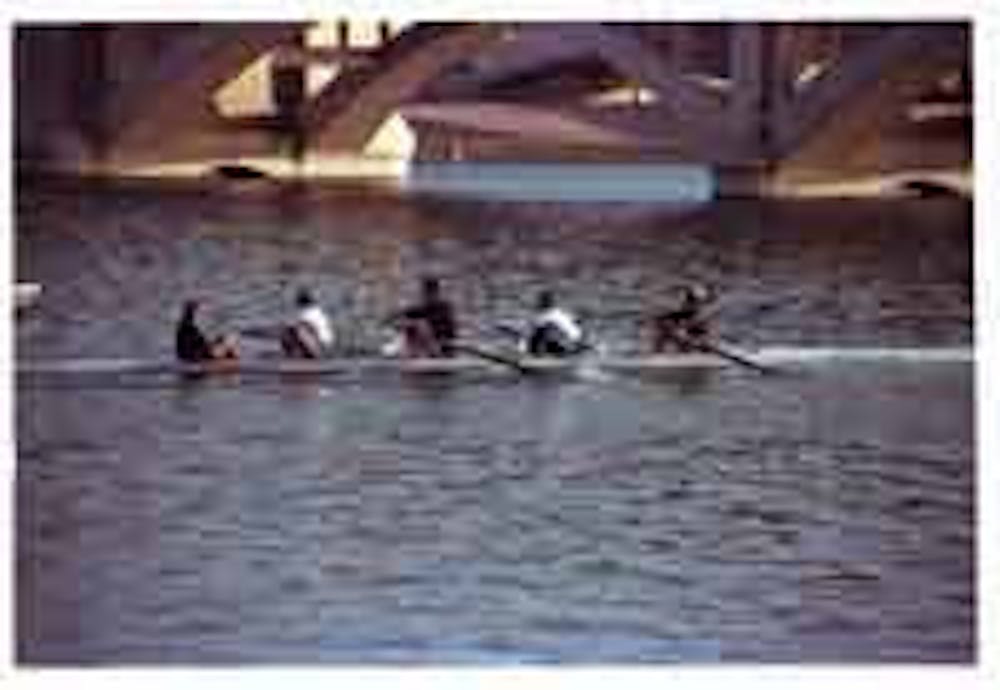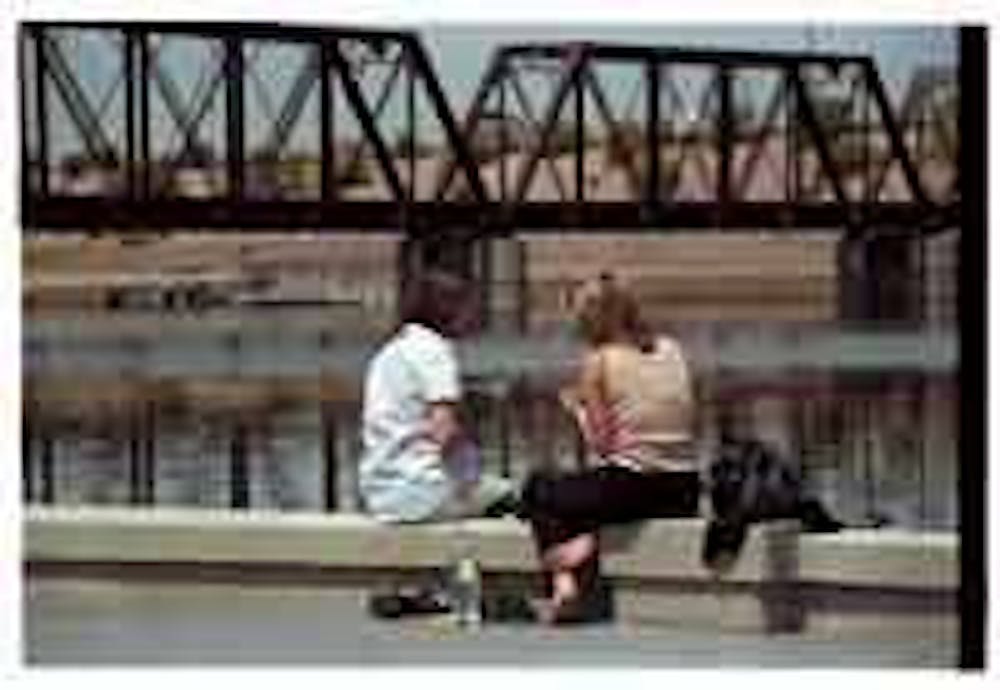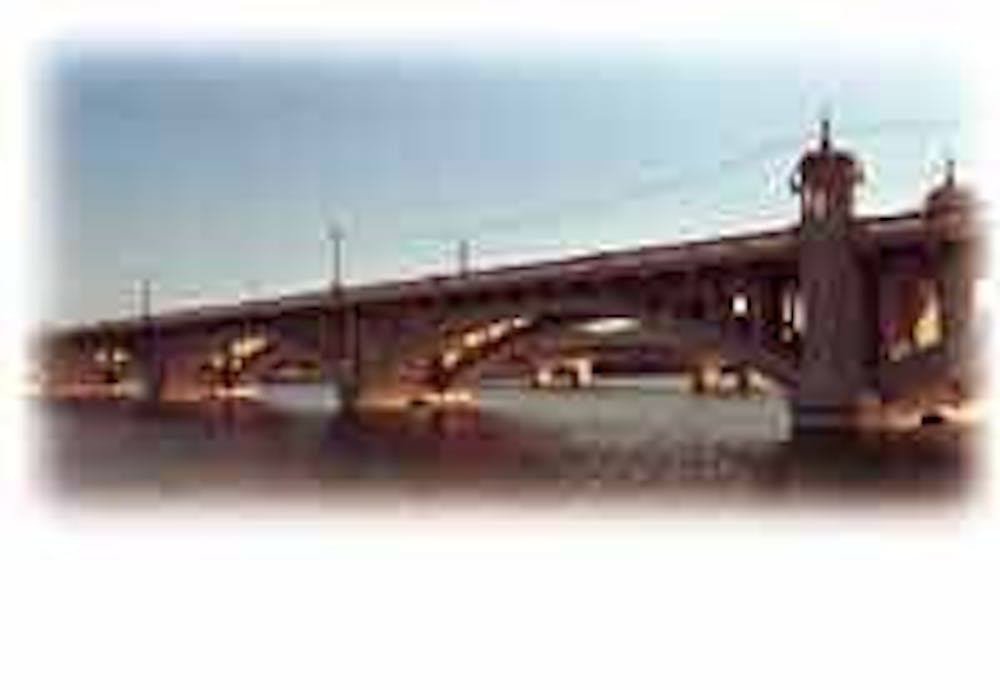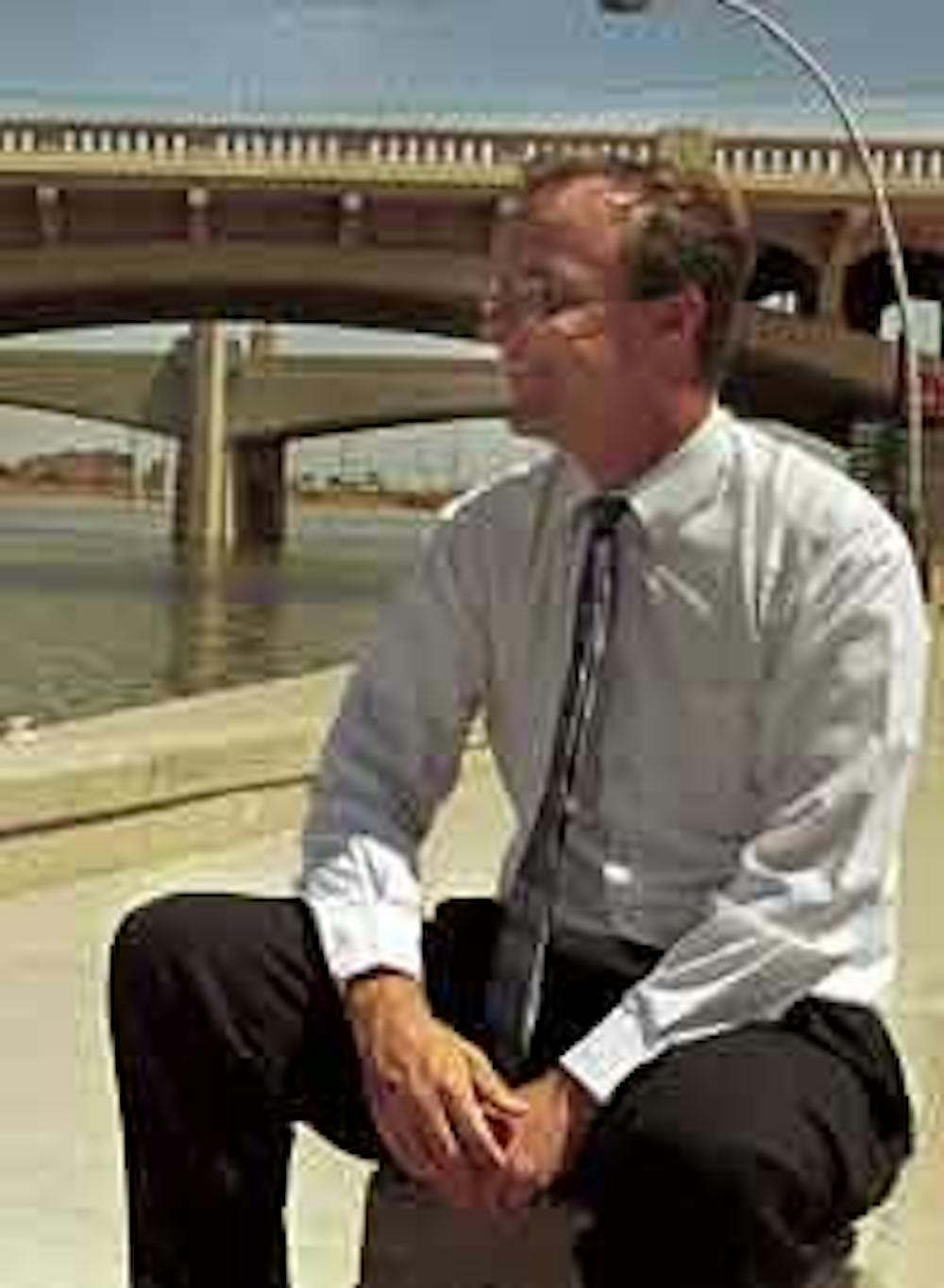A children's water park is under construction by Surface Creations near Tempe Town Lake. Kids will love it; they have a blast whenever water is involved, said the Mesa-based company's project manager, Susan Clark.
But according to some ASU professors, if a strong enough storm dumped water into nearby Tempe Town Lake, there would be more water than any full-grown adult could handle.
The lake is bordered by dry sections of the Salt River and is controlled by inflatable dams in the lake and four permanent dams upstream.
In case of a heavy storm, the dams would be lowered; the water would pass over them and flow to dry sections of the river.
Or maybe it wouldn't.
An intense storm could overflow the banks and do structural damage to the buildings that are proposed along the lake, said John Shaffer, a faculty associate in the ASU geography department.
"The Salt River is prone to flooding," Shaffer said. "(Tempe Town Lake) is a great place to visit. It's beautiful. I just think we shouldn't be surprised if the river floods and washes away parts of buildings."
In 1978, he said, water from a flood reached Sun Devil Stadium.
"It's very hard to change Mother Nature," Shaffer said. "People always think they can, but she thinks something different."
Dam problems
The Salt River dams were built to withstand a "100-year flood," an intense flood that is only supposed to occur once every 100 years. The Salt River has had three 100-year floods in the last three decades: one in 1972, one in 1978 and another in 1983.
In 1978, every bridge over the Salt River succumbed to flood pressure and came barreling down, Shaffer said.
Only the Mill Avenue bridge was unaffected, because it is built into solid bedrock, rather than the fickle ground usually found near riverbeds. It can withstand a lot of pounding, but every time a flood tears through, the structure weakens.
Shaffer isn't against the lake or the proposed development around it. But he is wary.
"In the immediate future the Tempe Town Lake project is fine and is great for the community," he said. "But there is potential for a playground built on a riverbed to not be a good idea."
"Things have been done to control flood levels and the water can be channeled away from recreational areas," Shaffer added. "It's still a bad idea though because in spite of what we've done to control the water, a flood can still come through and do quite a bit of damage."
The worst that can happen
If water overpowered the four dams that run from the Mogollon Rim in Payson south to the Valley and made its way to Tempe Town Lake, would the inflatable dams be able to withstand it?
Almost definitely, said Don Hawkes, Deputy Manager of the Tempe Water Utilities Department.
"Flooding was very much considered in the design," Hawkes said. "If we do have an intense storm, then dams would be put down and the water will flow through. We're ready for 100-year floods.
"But if we had a 500-year flood there would be water everywhere," he said. "That would definitely raise it above its banks."
Hawkes said it could be very damaging and Shaffer agreed. Buildings and landscaping would be in big trouble. "But would we see the Marriott floating down the river?" Shaffer asked. "No."
Neither of them is scared of a 100-year flood or a 500-year flood, and Hawkes doesn't think developers should be either.
"I think development along the area is a good idea," Hawkes said. "It will rejuvenate an area that used to just be a dumping ground."
A desert utopia
Until the 1930s, the Salt River ran freely year-round and looked very different than it does now, said Andrew Honker, an ASU history student who recently completed his dissertation, "A River Sometimes Runs Through It: A History of Salt River Flooding and Phoenix."
"I see the potential in using a dry river bed that used to have water in it as a recreational area," Honker said. "But what we have now is nothing like what it used to be."
What is now Tempe Town Lake would have been almost unrecognizable 70 years ago. The river was alive with water from upstream, which probably didn't look drastically different than it does now, but the area was filled with natural vegetation, Honker said.
Cottonwood trees lined the banks and a biological habitat thrived. When the Salt River was dammed, the water habitat near "A" Mountain dried up and just about everything died or was replaced.
Now there is grass on both sides of the lake and young trees are growing.
Three-eyed fish
Many people enjoy the lake each weekend for its beauty and recreational use, but not everyone is a fan. Many people believe the lake is polluted.
"That water looks really nasty," said Aaron Bortman, a computer science junior. "I have a lot of friends who live around here and none of them ever go to Tempe Town Lake.
"I think that if the water were nice and people could swim in it, then it would be a lot better and a lot more people would want to go down there," he said.
While rumors of the lake being full of "three-eyed fish," are indeed just rumors, scientists and water quality testers do not recommend drinking the water or having too much contact with it.
From atop "A" Mountain the lake looks blue, but up close it's brown, said Nancy Sellover, an assistant state climatologist.
Sellover researched the area for three years and earned her doctorate studying evaporation levels of the lake. She wanted to find out if the water would impact temperature or humidity levels in Tempe.
"It's not big enough to cause any real problems," Sellover said of the two-mile long body of water. "The lake's climate effects can only be felt when you're at the lake. If you're standing near it and wind comes toward you, you'll notice a little more humidity and in the winter it will be a little warmer and in the summer it's a little cooler. But if you're walking down Mill Avenue, you're not going to feel anything."
A safety concern
Tempe Town Lake is home to water-skiing competitions, boating races and cardboard-boat building/racing competitions. People are bound to get wet during these events, but it is not recommended.
"If you go boating on the lake, it's OK," Sellover said. "But you can't go swimming because they don't want you to swallow any of the water."
The city's plan is to eventually make the water healthy enough to swim in.
"At this point, they don't know when that will happen," Sellover said. "If you have an open cut, they don't recommend you put your hand in there because there might be a bacteria in it."
Sellover said the regulations may sound scary, but they really aren't.
"As long as they keep up doing the water quality tests, I don't have any concerns," she said. "There are no pollutants or anything that would mutate fish, but they do have a problem getting a biological balance that produces healthy water."
Everything in moderation
John Shaffer would be happy to see that biological balance be reached. It would open the lake up to more events and that would help Tempe's economy. He likes having water in the riverbed. He just doesn't want too much of it.
"People look at (the lake) and think it's peaceful, but what they don't realize is that with water in it, it is anything but peaceful," he said. "It's a dangerous waterbed."
Honker said his years of researching Salt River flooding have led him to the same conclusion.
"There are four dams on the Salt River designed specifically to handle a lot of water," Honker said. "But if we ran into some sort of technical glitch, who knows what could happen? One of the tough things about designing flood control is that there are so many variables you can't plan for. The potential for a problem is there."
"Nature can always throw you a curve ball," he added.
In the meantime, hundreds of people will continue to enjoy the lake. Some, like Linda Beller, a 49-year-old retired teacher, drive from other cities on a daily basis just to enjoy the park.
"I love it here," Beller said. "I live in Apache Junction, but I come here specifically to walk and Rollerblade. Some people hate the lake. It's controversial, I know, but I think it's a fabulous idea.
"You come here on the weekends and see everybody spending time with their dogs and kids," she said. "It's really a nice feeling."
The lake and its surroundings would feel nicer if they weren't dirty, said 11-year-old Joel House. House lives in Glendale but visits the lake occasionally with his mom and sister.
"It's a good place for fishing and rafting," he said. "It's sort of dirty though so someone should clean it up. I saw a beer can and a Cheetos bag today. It's a little dirty all the time."
But House said he'll keep coming back, and he isn't worried about any floods.
Tempe Town Lake at a glance
Location: In the Salt River bed, between Priest Drive and McClintock Road
Length: two miles
Max. depth: 19 feet
Avg. depth: 13.5 feet
Width: 1/4 mile
Volume: 2,500 acre-ft.
Dam Height: 6 ft. (at east end), 19 feet (at west end)
Cost: $45 million
Dedication: Nov. 1999
Source: http://www.srpnet.com/water/tempelake
Did you know?
The water that filled Tempe Town Lake came from the Colorado River. The water travelled 211 miles and took six-and-a-half days to reach the lake.
Source: http://www.srpnet.com/water/tempelake
Reach the reporter at michelle.beaver@asu.edu.







